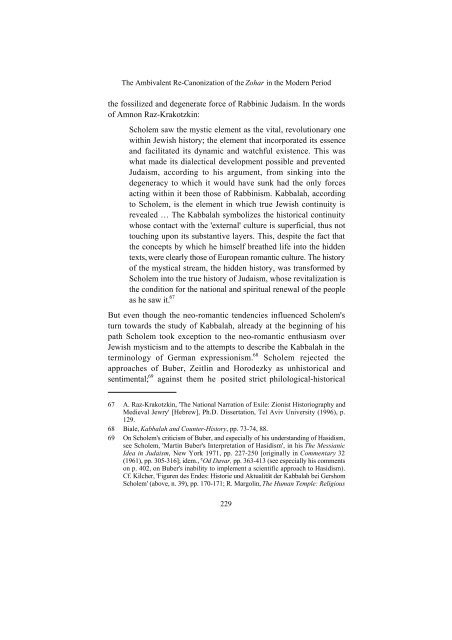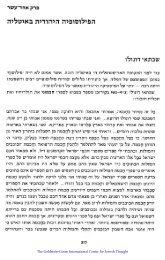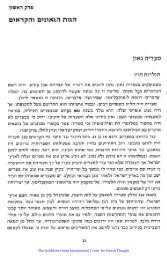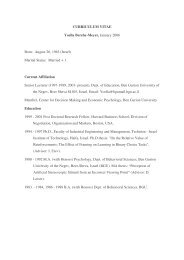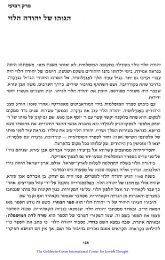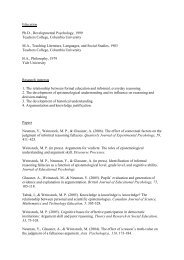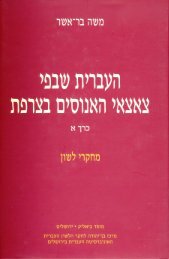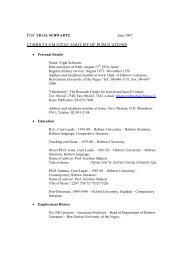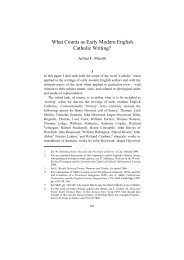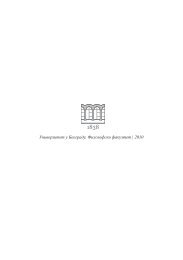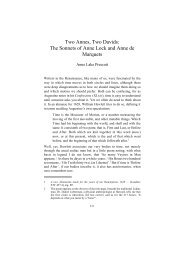Admiration and Disgust: The Ambivalent Re-Canonization of the ...
Admiration and Disgust: The Ambivalent Re-Canonization of the ...
Admiration and Disgust: The Ambivalent Re-Canonization of the ...
You also want an ePaper? Increase the reach of your titles
YUMPU automatically turns print PDFs into web optimized ePapers that Google loves.
<strong>The</strong> <strong>Ambivalent</strong> <strong>Re</strong>-<strong>Canonization</strong> <strong>of</strong> <strong>the</strong> Zohar in <strong>the</strong> Modern Period<br />
<strong>the</strong> fossilized <strong>and</strong> degenerate force <strong>of</strong> Rabbinic Judaism. In <strong>the</strong> words<br />
<strong>of</strong> Amnon Raz-Krakotzkin:<br />
Scholem saw <strong>the</strong> mystic element as <strong>the</strong> vital, revolutionary one<br />
within Jewish history; <strong>the</strong> element that incorporated its essence<br />
<strong>and</strong> facilitated its dynamic <strong>and</strong> watchful existence. This was<br />
what made its dialectical development possible <strong>and</strong> prevented<br />
Judaism, according to his argument, from sinking into <strong>the</strong><br />
degeneracy to which it would have sunk had <strong>the</strong> only forces<br />
acting within it been those <strong>of</strong> Rabbinism. Kabbalah, according<br />
to Scholem, is <strong>the</strong> element in which true Jewish continuity is<br />
revealed … <strong>The</strong> Kabbalah symbolizes <strong>the</strong> historical continuity<br />
whose contact with <strong>the</strong> 'external' culture is superficial, thus not<br />
touching upon its substantive layers. This, despite <strong>the</strong> fact that<br />
<strong>the</strong> concepts by which he himself brea<strong>the</strong>d life into <strong>the</strong> hidden<br />
texts, were clearly those <strong>of</strong> European romantic culture. <strong>The</strong> history<br />
<strong>of</strong> <strong>the</strong> mystical stream, <strong>the</strong> hidden history, was transformed by<br />
Scholem into <strong>the</strong> true history <strong>of</strong> Judaism, whose revitalization is<br />
<strong>the</strong> condition for <strong>the</strong> national <strong>and</strong> spiritual renewal <strong>of</strong> <strong>the</strong> people<br />
as he saw it. 67<br />
But even though <strong>the</strong> neo-romantic tendencies influenced Scholem's<br />
turn towards <strong>the</strong> study <strong>of</strong> Kabbalah, already at <strong>the</strong> beginning <strong>of</strong> his<br />
path Scholem took exception to <strong>the</strong> neo-romantic enthusiasm over<br />
Jewish mysticism <strong>and</strong> to <strong>the</strong> attempts to describe <strong>the</strong> Kabbalah in <strong>the</strong><br />
terminology <strong>of</strong> German expressionism. 68 Scholem rejected <strong>the</strong><br />
approaches <strong>of</strong> Buber, Zeitlin <strong>and</strong> Horodezky as unhistorical <strong>and</strong><br />
sentimental; 69 against <strong>the</strong>m he posited strict philological-historical<br />
67 A. Raz-Krakotzkin, '<strong>The</strong> National Narration <strong>of</strong> Exile: Zionist Historiography <strong>and</strong><br />
Medieval Jewry' [Hebrew], Ph.D. Dissertation, Tel Aviv University (1996), p.<br />
129.<br />
68 Biale, Kabbalah <strong>and</strong> Counter-History, pp. 73-74, 88.<br />
69 On Scholem's criticism <strong>of</strong> Buber, <strong>and</strong> especially <strong>of</strong> his underst<strong>and</strong>ing <strong>of</strong> Hasidism,<br />
see Scholem, 'Martin Buber's Interpretation <strong>of</strong> Hasidism', in his <strong>The</strong> Messianic<br />
Idea in Judaism, New York 1971, pp. 227-250 [originally in Commentary 32<br />
(1961), pp. 305-316]; idem., ‘Od Davar, pp. 363-413 (see especially his comments<br />
on p. 402, on Buber's inability to implement a scientific approach to Hasidism).<br />
Cf. Kilcher, 'Figuren des Endes: Historie und Aktualität der Kabbalah bei Gershom<br />
Scholem' (above, n. 39), pp. 170-171; R. Margolin, <strong>The</strong> Human Temple: <strong>Re</strong>ligious<br />
229


